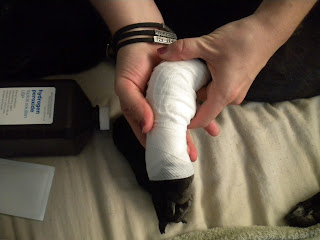How to Bandage A Wound
 |
| "What's all this Mom?" |
Every dog owner should know how to do some basic first aid on their dogs. So I am going to teach you how to bandage a wound on your animal.
1.) Clean the wound
If your dog has been bitten or has a minor scrape or cut and you want to protect it from infection, the first step is to clean the wound. I recommend a 3% solution of Hydrogen Peroxide. You can buy it over-the-counter at most large retailers (Target, WalMart, Walgreens, Longs, RiteAid, The Dollar Tree, ect). There is some controversy over the use of Hydrogen Peroxide to treat infections; it is said that it kills good cells as well as bad. I believe that the 3% solution that is available over-the-counter is not strong enough to do anything detrimental to good cells, plus I have never had anything but good come from using it. So it is my weapon of choice against infection. There are other options as well, like rubbing alcohol, soap and water, even neosporin.
Pour a bit of the hydrogen peroxide onto the wound and wait 30 seconds. It should bubble as it encounters bacteria Repeat 4 or 5 times and then rinse with clean water.
2.) Dry
Pat the area dry with a clean cloth or paper towel.
3.) Place non-stick gauze-pad over wound
You want to use a non-stick pad under the gauze wrapping because you need something to protect the wound from the gauze.
4.) Wrap with gauze
This is to hold the non-stick pad in place over the wound. Wrap the gauze around the affected limb or area as you would with a human. If you are wrapping a foot, be very careful not to wrap it too tight. A bandage that is wrapped too tightly can cause swelling in the foot.
5.) Wrap with athletic tape
This is to keep the gauze from slipping off. Athletic tape is stickier than gauze and it sticks to itself so there is no need for any additional tape. Again, be careful not to wrap the area too tightly. It is a very fine line between tight enough to hold it in place and being too tight.
6.) Watch carefully for 24 hours
This step is one of the most important. I am speaking from personal experience here. When my dog had her dew-claws removed I had to change the bandages a couple of times after her sutures were removed because she licked the suture site bloody. The second time I did this I wrapped the bandage too tightly and 12 hours later I noticed her paws were double the size they should have been. This is why it is important to keep a close eye on the area you bandaged.
If you do notice swelling, remove the bandage IMMEDIATELY. Rub the paw and the leg to try to restore circulation. The swelling should go down on its own within a few hours, but make sure to check the temperature of the affected paw against the unaffected ones every 30 minutes or so. If you notice that the swollen paw is hotter or colder than the others, call a Veterinarian.
7.) Repeat as nessecary.
Please note that if your dog has sutures, you do not want to get those wet under any circumstances, so if they rip off the bandage or somehow lose it, skip straight to step 3.
Congratulations! You now know how to bandage a wound on a dog! Hopefully, you are able to put this advice to good use and hopefully you won't need to use this knowledge too often!






Easy to follow instructions, I liked the read. I would look up official information detailing if hydrogen peroxide will injure the dog as well, so you sound more informed. Also, I would do research on removing the bandage if the dog's paw is swollen to that size, especially for 12 hours; as clots can form, and cause further damage to the animal if released into circulation.
ReplyDeleteI liked your instructions a lot. it was very thorough. Your idea at the end to add pictures would be very helpful so that people can get a visual idea of how to wrap the bandage and what the finished product will look like. As far as the 3% hydrogen peroxide, do you know what the product is called? My contact solution is 3% hydrogen peroxide- you can use that as a suggestion maybe?
ReplyDeleteI liked how you went into detail but you could go into more detail about sticking a non-stick gauze-pad over wound and the dry. But good job on it all. Cant wait until until i get to see the picture.
ReplyDelete